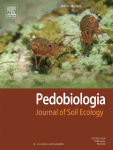Ver ítem
- xmlui.general.dspace_homeCentros Regionales y EEAsCentro Regional Patagonia SurEEA Santa CruzArtículos científicosxmlui.ArtifactBrowser.ItemViewer.trail
- Inicio
- Centros Regionales y EEAs
- Centro Regional Patagonia Sur
- EEA Santa Cruz
- Artículos científicos
- Ver ítem
Differential responses of soil microorganisms to precipitation changes in austral semiarid grasslands
Resumen
Global climate models predict that precipitation regimes will change, generating great impacts on various ecosystem processes and functions. Therefore, it is important to know how drought and precipitation increases would affect the soil microorganims and plants. We established a precipitation manipulation experiment, with treatments ranging from 54% reduction (drought) to 54% increases (irrigation) in a semiarid ecosystem, and measured microbial carbon
[ver mas...]
Global climate models predict that precipitation regimes will change, generating great impacts on various ecosystem processes and functions. Therefore, it is important to know how drought and precipitation increases would affect the soil microorganims and plants. We established a precipitation manipulation experiment, with treatments ranging from 54% reduction (drought) to 54% increases (irrigation) in a semiarid ecosystem, and measured microbial carbon (MBC) and nitrogen (MBN), soil basal respiration (SBR), microbial metabolic coefficients (qCO2), and estimated the sequestration and fluxes of CO2 by soil microorganisms. While simulated
drought did not modify the microbial community attributes, the microbial biomass increased with greater precipitation, which in the long term could lead to greater carbon (C) sequestration by the microbial pathway and a decline in potential CO2 emissions into the atmosphere. This study shows that microorganisms of the semiarid soil are able to withstand drought and are possibly able to adopt resistance mechanisms under dry conditions. However, drought or increased precipitation did not affect SBR. The results showed that plants’ and soil microorganisms’ responses to precipitation change were asymmetric and different. The study quantifies the
contributions of microorganisms to sequestered C by soil microbial biomass (≈35 g MBC m− 2) and CO2 fluxes to the atmosphere (removed in MBC ≈127 g CO2 m− 2 and emission by SBR ≈876 g CO2 m− 2 yr− 1) in semiarid ecosystems. This study not only increases our understanding of the adaptation of soil microorganisms to precipitation changes but also provides new insight into the contributions of the microorganisms when modeling and projecting implications for C cycling.
[Cerrar]

Autor
Fuente
Pedobiologia 97-98 : 1-10 (2023)
Fecha
2023-06
Editorial
Elsevier
ISSN
0031-4056
Formato
pdf
Tipo de documento
artículo
Palabras Claves
Derechos de acceso
Restringido
 Excepto donde se diga explicitamente, este item se publica bajo la siguiente descripción: Creative Commons Attribution-NonCommercial-ShareAlike 2.5 Unported (CC BY-NC-SA 2.5)
Excepto donde se diga explicitamente, este item se publica bajo la siguiente descripción: Creative Commons Attribution-NonCommercial-ShareAlike 2.5 Unported (CC BY-NC-SA 2.5)


